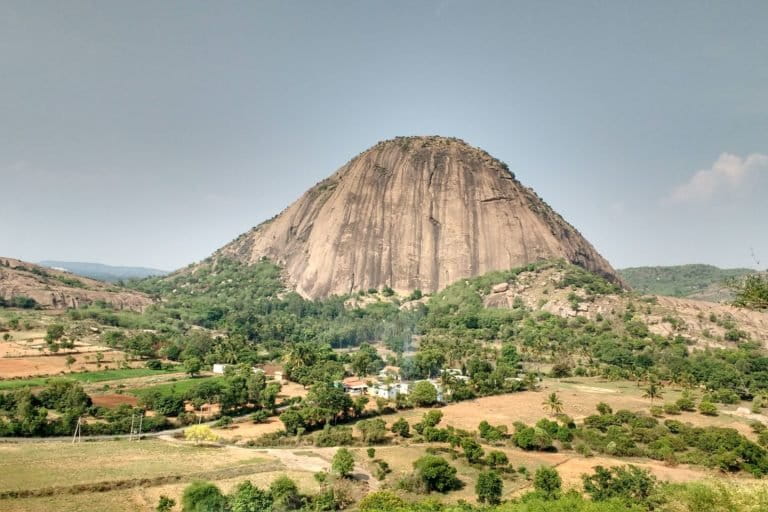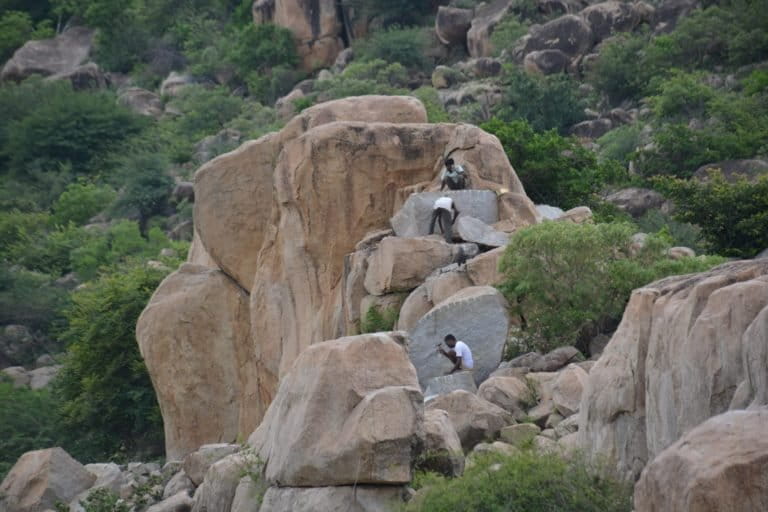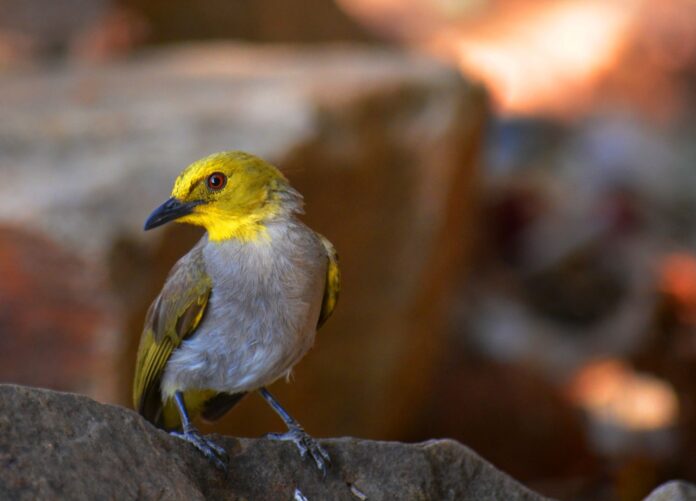The word ‘hill forest’ often brings up an imagery of a tall cliff draped in dense greenery, rising from the plains, peaking high to vanish amidst the mist. Though that is certainly true for the Western Ghats, the inland hillocks of the Deccan region do not conform to this. These are isolated hillocks, rising 500-1000 m above earth’s surface, found across Southern India between the Eastern and Western Ghats. They consist of huge granitic monoliths, naked rock sheets and sparsely distributed trees and thickets, justifying their other names as granitic inselbergs or rocky outcrops.
Precariously placed rocks and boulders are signatures of inland hillocks of the Deccan. The rocks predate the Himalayas by 50-100 million years; eons of weathering and climatic events have eroded much of their top soil. In the scorching heat of a typical summer noon, the withered bushes and stunted trees might give an impression of a silent and drowsy ecosystem to an uninitiated eye.

However, this seemingly barren land hides the treasure of life. Beneath these rocks, one will find moist patches supporting mosses and ferns. There are no streams cascading through them. But water trickling through these rock layers creates a microcosm. It is around such moist patches that one finds tall lush green trees, in an otherwise arid landscape. Rock crevices hold moisture, and provide safe refuge for tree sprouts, insects and various reptiles.
While the noon is silent, mornings and evenings in these hillocks are bright and loud. Amidst the clamour of a variety of birds in the region, one might hear the distinct sharp call of yellow-throated bulbul (YTB) as it skulks within the bushes and hops on the rocks. This bird is more often heard than seen.
The YTB as it is called, is a sparrow-sized bird and weighs around a mere 30 g. It is mostly found in pairs and is seen foraging for figs or berries and occasionally it can be seen sallying in the air and catching insects. It is found across five states of southern India – Telangana, Andhra Pradesh, Tamil Nadu, Karnataka and Kerala, exclusively along the slopes of inland hillocks, Eastern Ghats and Southern Western Ghats. Though spread over a fairly large area, it is a rare species with a patchy distribution.
Detailed natural history observations on YTB are scarce. Information on its breeding, feeding and movement data comes from opportunistic sightings. So far, we know that YTB is restricted to rocky hill slopes, and does not appear to wander into plains. Temperatures do not fluctuate much between boulders and in rock crevices as it would in the open plains. This is why it is thought the YTBs prefer this habitat.
Inland hillocks are, sometimes, found in clusters spread across a vast terrain. Suitable habitats for YTB can be up to 100-200 km apart surrounded by plains or few rocky clusters. A recent study found YTB’s population expanded about a million years ago. The fossilised pollen records from this region reveal that southern India was humid and wet once upon a time. The landscape gradually dried later. The moist forests were replaced by dry and scrub forests, and YTB expanded its range by occupying this newly available habitat.
The study also found that YTBs found in distant habitats across southern India are not genetically different from each other. The study concluded that YTB uses intervening suboptimal habitats to disperse, find mates from far-off places, and, thus, its population maintains genetic diversity. The greater the genetic diversity of its population, the better is its health and vigour.
Habitat connectivity allows the population to avert possible local extinctions. Thus, YTBs not only need the prime habitats in the form of intact rocky hillocks, but connectivity between them to maintain a healthy population.

Multiple threats to the environment
The tables have turned today for YTB as these habitats are undergoing another transformation. Loping of trees for fodder and soil mining for brick making negatively affect YTB habitat. Most inland hillocks house a shrine or are places of pilgrimage. Economic activities and noise pollution from loud speakers at such religious enclaves add to the ever-expanding human footprints at YTB habitat.
These regions are rich with granite, a commercially valuable mineral used in tiling and as construction aggregate. India is a leading exporter of granite in the world. The YTB habitats are extensively mined. A study found that only about 12% of the distribution range of YTB is currently protected, and the rest is available for commercial exploitation.

These hillocks are not only home to the endemic YTB. They house many other species such as slender loris, tree shrew, golden gecko, white-naped tit, painted spurfowl, the endemic cycads, the nutritious fruit-bearing Ficus trees, and possibly even the enigmatic Jerdon’s courser – the one that has never been sighted since 2005.
Climate change adds to their adversities. It is predicted that the ambient temperature will rise and rainfall patterns will alter. This would have massive repercussions on the lifecycle of plants and animals which are finely tuned in response to rainfall and temperature. It is expected to upset the synchrony between breeding cycles of birds, insects and plants, and thus, change habitat characteristics and lives of all those dependent on it. It is predicted that under an extreme scenario, suitable habitat of YTB will shrink by 42% by 2070.
In the impending alarm of climate change, inland hillocks help in maintaining microclimates amid their rocks. These can provide refuge against rising temperatures, and thus offer a buffer against climatic alterations. Despite their indispensable contribution to the Deccan ecosystem and their conservation relevance, inland hillocks remain severely under-studied and under-valued. Instead, they are fast vanishing to commercial activities.
The yellow-throated bulbul can be the mascot for conservation
Scrub forests of Eastern Ghats and inlands hillocks do not receive conservation attention as they do not conform to the traditional notion of ‘forest’. They are classified as wasteland in forestry parlance. They lack megafauna as the tigers, and hence, do not gather the conservation attention it rightly deserves.
This lack of appreciation for non-forest habitats such as grasslands has severely compromised the population of the iconic great Indian bustard. This mighty endemic bird, which was once a contender for the title of India’s national bird, is locally extinct in southern India, and is on the verge of global extinction with less than 100 breeding individuals. Policymakers and conservationists have to broaden their idea of ‘forest’ and appreciate life forms thriving in all ecosystems so that no more species suffer the fate of the great Indian bustard.
It is now imperative for the Deccan inland hillocks to consider stronger conservation strategies. It desperately needs a flagship species, whose population health can be monitored as a representative for the entire ecosystem in the hillocks as well as the connecting plains.
Given that we find that the YTB population is currently genetically healthy, and we have the means to monitor them makes this charming bird a strong contender to be the flag bearer for the Deccan inland hillocks. They are often seen around the temples with Ficus trees, and thus, it is easy to build a cultural connection for people around there.
The regular sightings of YTB would suggest their healthy population, availability of food plants, water sources, less or no anthropogenic disturbance and habitat connectivity with surrounding regions. The YTB can become the face of conservation programs this area needs.
This article was originally published in Mongabay.
Ashish Jha is a field ornithologist, and he has worked on evolution, niche and population genetics of Yellow-throated Bulbul as a part of his PhD research at CSIR-Centre for Cellular and Molecular Biology (CCMB) Hyderabad. Somdatta Karak leads science communication and outreach at CSIR-Centre for Cellular and Molecular Biology, Hyderabad. She is interested in engaging young local communities toward sustainability.
CITATION:
Jha A and Vasudevan K. 2020. Demographic history of the fragmented Yellow-throated bulbul (Pycnonotus xantholaemus) population in the Deccan Peninsula, India. Endangered Species Research 43:199-207. DOI: https://doi.org/10.3354/esr01062. Link: https://www.int-res.com/articles/esr2020/43/n043p199.pdf
Jha A and Vasudevan K. 2020. Environmental niche modelling of globally threatened Yellow-throated bulbul, Pycnonotus xantholaemus for conservation prospects in the Deccan Peninsula, India. Current Science 119 (11): 1815-1823. Link: https://www.currentscience.ac.in/Volumes/119/11/1815.pdf
Banner image: The yellow throated bulbul, around 18-20 cm in size, with a yellow head, throat, tip of wings and tail, under tail coverts, a grey breast and belly, a short and dark-grey bill. Photo by Ashish Jha.


